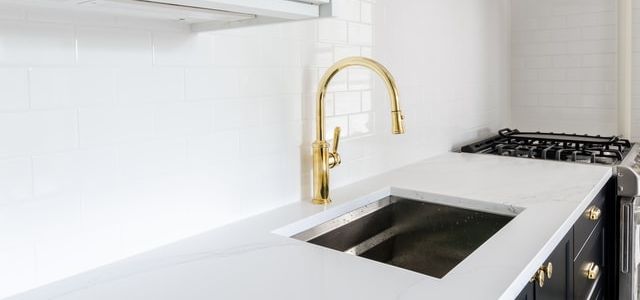Installing a faucet is easy, right? Well, if you know what you’re doing and if you have access to the appropriate tools, then yes. But what if this isn’t the case? What if you have no idea how to remove your old faucet? Or maybe you don’t own any tools?
Many times, a home buyer’s eyes wander over directly to the sink, both to admire its beauty and also because it is a great barometer for the quality of construction of the home. But how often do we actually think about our kitchen sink? A quick look under the kitchen sink might reveal some chaos, but as long as everything fits inside, it doesn’t really matter. However, if you’re still using that old faucet you had in your previous apartment, it may now be time to make a change.
Table of Contents
Turn off the water
The first step in replacing a kitchen faucet is to turn off the water to the faucet. If you have separate shut-off valves for hot and cold, close both. If not, close the main water shut-off valve for your home. Then turn on the faucet to relieve the pressure in the lines and make sure there’s no residual water left in them.
Once you’ve cut off the water, remove the existing faucet. To do this, disconnect the supply lines and unscrew any mounting nuts that are holding it in place. Once you’ve removed all of these components, carefully pull out the old faucet.
Disconnect the water lines
Disconnect the water lines. Turn off the water supply to the faucet. For a sink with a single handle, turn off the water at the valves located underneath the sink. For a double-handled sink, turn off the hot and cold valves located on either end of or under the sink. Place a bucket under each valve, then loosen and remove the supply lines to drain any excess water into the buckets.
Remove the faucet from the top of the sink. If your old faucet has handles attached to stems that go through holes in your countertop or sink, you’ll need to remove them before taking out your new faucet. Find any nuts or bolts holding these handles in place and use a screwdriver or wrench to remove them. Then lift out the old faucet and set it aside.
Disconnect the faucet
- Turn off the water supply to the faucet. If your faucet has a sprayer, open it so no pressure will build up when you disconnect the water lines.
- Disconnect the water supply lines from the faucet. You may need to use a wrench or pliers to loosen them. If you are replacing a pullout faucet, slide the hose through the spout before removing it.
- Remove any mounting nuts and clips that hold the faucet in place. They may be located on top of the sink or under it.
- Pull out and remove the old faucet.
Install the new faucet
The new faucet will come with its own installation directions, but the basics are the same for most models. You’ll usually have to attach the new sprayer before you mount the faucet, because it’s easier to work under the sink that way.The first step is to install plastic mounting nuts on the ends of the supply lines. Most faucets use threaded brass or copper supply tubes with compression fittings.
The nuts hold the faucet against the sink and keep it from wobbling when you turn it on.If your old faucet had a brass or copper supply line, you’ll need a piece of flexible water-supply tubing to connect it to your new faucet. Measure and cut it so that it extends about 1 in.
Attach the water lines
If you’re installing a new faucet, screw on the rubber washers and plastic (or brass) nuts that came with the faucet. If you’re replacing an existing faucet, you’ll find it easier to install the new one if you loosen the old one first. Leave it hanging in place while you work. Unscrew the old lines and remove them from the shutoff valves. Screw on new lines to the shutoff valves. Attach the other end of each line to its fitting under the faucet. Turn on both shutoff valves to test for leaks before tightening any connections too much.
Connect the mounting nuts and turn on the water
Once the water is turned off, disconnect the hoses from the old faucet. If your faucet has quick-connect fittings, you may need to remove a ring below the hose connection before pulling it out.
- With the hoses removed, remove any nuts or bolts that hold the old faucet down and pull it up out of the hole.
- Clean any caulking or putty on the sink surface with a putty knife or scraper and place plumber’s putty under the new faucet mounting ring(s). Set the new faucet in place, reconnect the hoses, and tighten down the mounting nuts.
- Turn on the water supply, then turn on each handle to check for leaks. Let the water run for
Conclusion
You should be equipped with a set of tools and know where all shut-off valves are located before you begin to install a kitchen faucet.Before you start the job, be sure to plan carefully. If time permits, it’s always a good idea to lay out all of your tools and pipes in advance; doing so will help you better identify and control any potential confusion that may arise.
Make sure that you have a drain pan handy as well; if water should spill across the counter, a pan will make cleanup a breeze. Finally, put safety first, and do not force any partsif something appears to be faulty or broken, consult your manual or call on a professional for assistance before proceeding.
